Swiss Air Force
Tucked away
in central Europe, bordered by NATO states Germany, France and Italy and neutral
Austria and not to forget Liechtenstein one finds the country of Switzerland.
Famous the world over for it's cuckoo clocks and financial institutions, the
country has followed a neutral policy for centuries and managed to stay out of
both World Wars. So neutral is Switzerland that it has not been a member of the
United Nations until very recently. In Western Europe there have been two models
of neutrality, unarmed neutrality as practiced by Ireland and armed neutrality
as pursued by Sweden and also Switzerland. The prosperous Swiss nevertheless
have always had Armed Forces to defend their nation. Especially since
World War II, but also before this conflict military aviation played it's part
in the defence of this Alpine nation. First formed in 1914 as the Fliegertruppe,
the Air Force was until 1996 known as the Kommando der Flieger und
Fliegerabwehrtruppen (Air force and Anti-Aircraft Command) and as such
subordinate to the Army. Since 1996 howver, the term Luftwaffe is used for the
independent Air Force.
During the
1950's and 1960's any invading force would find itself in the middle of a
hornet's nest of Vampires, Venoms and Hunters, backed up in the sixties with the
then top of the line of European Mach 2+ fighters, the Mirage III. The 1970's
through the 1990's saw the retirement of the Vampires followed by the Venoms and
Hunters but on the other hand the introduction of the F-5E Tiger II.
The end of
the Cold War brought with it a considerable scaling down of the Air Force, the
Armee XXI programme is still ongoing at this time, but at the same time more
modern types like the F/A-18C/D Hornet and AS.332 Super Puma found their way
into the ranks. Historically the Swiss Armed Forces have relied heavily on
reservists who after their period of military service would be called up anually
for a two week Wiederholungskurs (Rehearsal Course). In fact, the wartime Swiss
Air Force would have consisted for a major part of reserve personell manning
squadrons which would in peacetime have lied dormant most of the time. Only
during exercises and actual conflict would these people and their units be
activated. However, the newer equipment like the Hornet with it's complicated
systems require constant training in order for it's users to stay current and is
thus less suited for "Milizia" pilots. The older and more austere F-5
is a different matter in that respect.
Transport
assets are few and are limited to PC.6 Turbo Porter light transports and Super
Puma and AS.532UL Cougar helicopters. Being neutral, the Swiss train their
pilots in-country on indegeneous PC.7 trainers. However, in order to fully
exploit the possibilities of the fighters the Luftwaffe does take part in
training exercises abroad like Air Combat Manoeuvering above the North Sea from
RAF Waddington (NORKA) and night flying training in Norway (NIGHTWAY).
Below you
will find examples of all types flown by today's Schweizer Luftwaffe.
All pictures (c) Hans Rolink.
|
Most
numerous of Swiss Air Force fighters is the Northrop F-5E Tiger II. A
total of 110, of which 98 F-5E single seaters and 12 F-5F two seater
trainers, were procured to replace the Hawker Hunter in the interception
role.
In
this picture, F-5E J-3073 bearing
the badge of Fliegerstaffel 13 taxis in after a mission during a
"Wiederholungskurs" (see above).
Turtmann,
10 March 2003. |
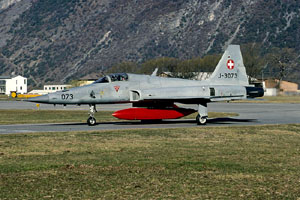
|
|
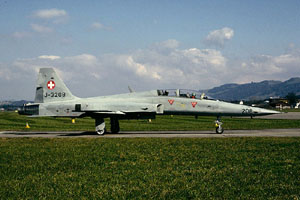
|
Further
scaling down of the Luftwaffe under the terms of the Armee XXI scheme will
see the number of operational F-5's to be reduced to just 54. Some of the
retired jets will go to the U.S. Navy to serve as agressors. Excellent
Swiss maintance and a low usage rate will certainly appeal to their new
owners. This view of F-5F J-3208
was captured at the Air Base of Emmen close to the city of Luzern.
Emmen,
13 March 2003. |
|
Birth
place of the Swiss Air Force is the Air Base of Dübendorf near Zürich.
The picture shows J-5024, one of
26 F/A-18C Hornet single seat multi-role fighters after landing. Although
a very capable ground attack platform, no specialized air-to-ground
weapons are currently used by this type.
Dübendorf,
14 March 2003. |
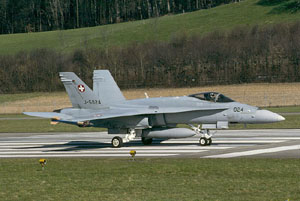
|
|
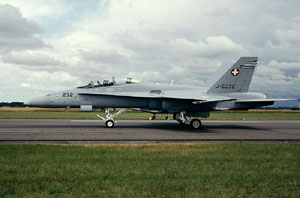
|
During
the long years of the Cold War Swiss seclusion hardly allowed air show
appearances outside of the country. Things started to change however
during the 1990's. In this picture, F/A-18D two seater J-5232,
one of eight delivered, took part in a French Air Force Open Day some years ago.
Dijon-Longvic,
29 June 1997. |
|
Remarkable
for such a small Air Force, no less than three types of fast jet were
being flown as recently as 2003. Dassault Mirage IIIRS R-2118
bearing the marks of Fliegerstaffel 10 is one of the last of this
dedicated reconnaisance type to be operated by the Luftwaffe. The curtain
will fall for the Mirage in October 2003. Unfortunately there will be no
comparable replacement, recce work is to be done by drones....
Dübendorf,
14 March 2003.
|

|
|
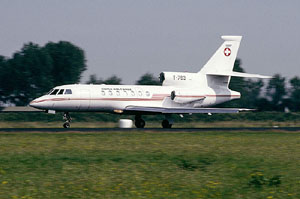
|
Transporting
VIP's is a mission for which many Air Forces operate off the shelf
business jets. In the case of the Schweizer Luftwaffe two types, one
example of each, are being used.
In
this picture, Dassault Falcon 50 T-783
can be seen taking off during an Open Day of the Royal Netherlands Air
Force.
Leeuwarden,
6 July 2001. |
|
The
other Swiss Air Force VIP ship is Learjet 36 T-781.
Like the Falcon above it is being flown by the VIP flight at Dübendorf.
It was not captured in Switzerland however, but in Belgium.
Beauvechain,
3 September 1999. |
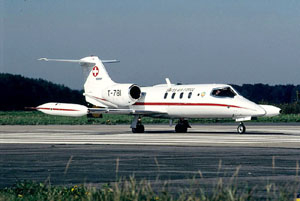
|
|

|
Ungainly
it may be, but the Pilatus PC.6B/H-2 Turbo Porter is certainly effective
in it's task. Being a true STOL light transport even Alpine meadows,
provided they are not too steeply inclined, are not out of bounds for this
modern day Fieseler Storch. V-612
taxies in on it's regular shuttle during an exercise at a temporary base.
Turtmann,
12 March 2003. |
|
While
other Air Forces use the Pilatus PC.9 as a trainer, the Luftwaffe operates
11 as target tugs for gunnery training. The badge right in front of
the cockpit belongs to Fliegerstaffel 24. Note the orange target under the
right wing of C-401.
Sion,
11 March 2003. |
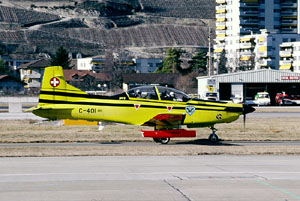
|
|
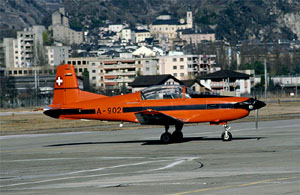
|
The
immediate predecessor of the PC.9 may be seen here. The Pilatus PC.7 Turbo
Trainer is one of the best selling turbo prop driven trainers world wide
and was a natural choice for the Luftwaffe. As the first of 40, A-901, has
been donated to the Luftwaffe museum at Dübendorf, A-902
is the oldest still in use.
Sion,
11 March 2003. |
|
After
having enjoyed one of the briefest of careers of modern time, Swiss BAE
Hawk T.Mk 66's were retired during late 2002. Force reductions including
retirement of part of the F-5 fleet, impending withdrawal of the Mirage
and even former Swissair pilots returning to the Air Force reduced the
need for an advanced trainer. Part of the Hawk fleet had already been
retired when the axe for the remaining 12 fell rather unexpectedly. The
aircraft are being kept airworthy to retain their sales value, however. U-1265
was being towed for testing when this picture was made.
Sion,
11 March 2003. |
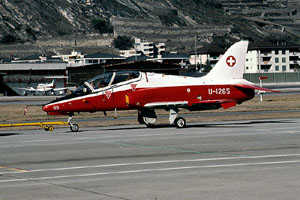
|
|
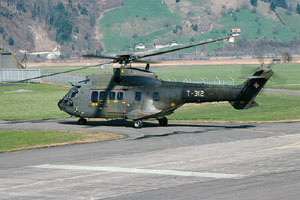
|
Referred
to by the Swiss Air Force as TH-86 (Transporthubschrauber 86) due to being
procured in 1986, AS.332M-1 Super Puma T-312
taxies in at it's home base Alpnach, a former F-5 reserve base.
For
those used to NATO air bases, Alpnach is a strange place. Only the
flightline and hangar have been fenced off, causing this Super Puma to enter a
gate before reaching it's parking spot.
Alpnach,
13 March 2003.
|
|
Such
was the success of the Super Puma in service that 12 of the militarily
optimised AS.532UL Cougar was ordered following introduction of 15 Super
Pumas. External differences are limited and identification is only
feasible by serial number. All machines above T-331 are AS.532UL Cougars.
One of these is T-340 known in
the Luftwaffe as TH-98. It has been fitted with skids to allow operations
on soft snow. Such conditions can be plentiful around Alpnach.
Alpnach,
13 March 2003.
|
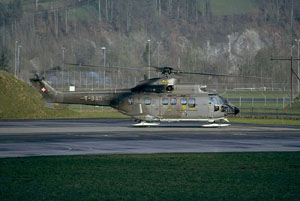
|
|
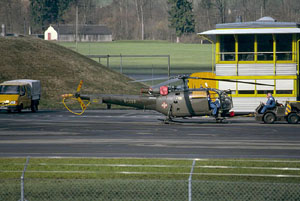
|
Sturdy,
simple and reliable. Three words to describe the trusty SA.316B Alouette
III. Nevertheless, the number in service, once as many as 84 helicopters
will be reduced to just 35 in the next few years as the Luftwaffe
implements the Army XXI programme. V-265
is being pushbacked out of it's hangar. Note the skids on it's
undercarriage.
Alpnach,
13 March 2003. |
Further
information on this interesting Air Force may be found at Christoph Kugler's
excellent AirPic site at http://www.airpic.ch.
Home













